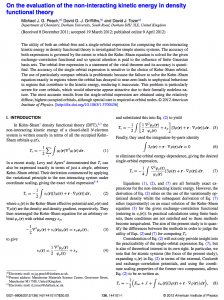On the evaluation of the non-interacting kinetic energy in density functional theory
Michael J. G. Peach, David G. J. Griffiths, David J. Tozer, J. Chem. Phys., 136, 144101, 2012.
Commentary
Citations
2
Citations
2
Another paper that came about as part of a 4th year research project, this paper investigates the practical usefulness of an expression developed by Levy and Ayers for the evaluation of the non-interacting kinetic energy in terms of a single Kohn–Sham orbital, which would have many computational advantages if it were practical. We highlighted some interesting problems arising from the approximate solution of the Kohn–Sham equation that leads to unphysical behaviour in orbitals that does not ordinarily manifest in practical calculations.
Further information, including details of subsequent work in this area, can be found on the research page. For the abstract, and access to the full text, see below.


Leave a Comment